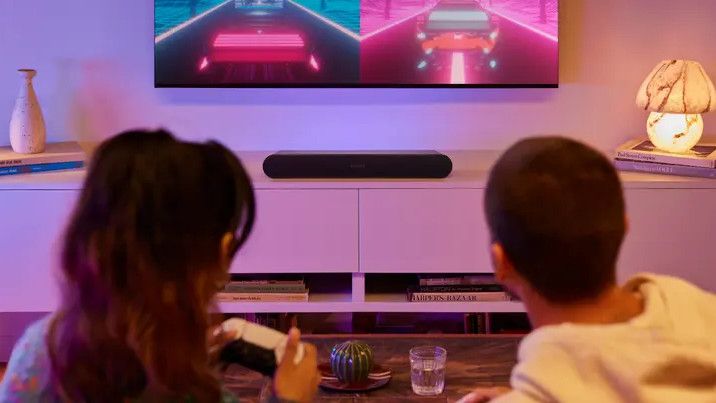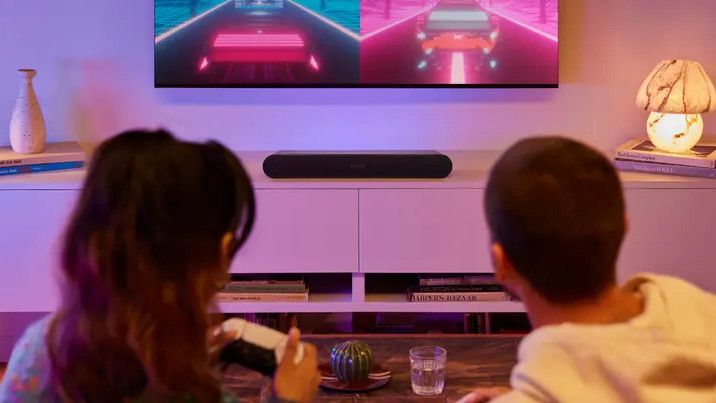
Sonos has launched its latest soundbar – and it comes with a budget-friendly price that’s uncharacteristic of the high-end multiroom audio brand.
The new Sonos Ray is a compact soundbar that’s designed to boost your TV’s audio, and it’ll be available to buy on June 7 for just $279 / £179 / AU$399.
That’s far cheaper than any other Sonos soundbar to date. Until now, the best option for those on a budget was the Sonos Beam (Gen 2), which costs $399 / £339 / AU699. Meanwhile, the brand’s flagship Sonos Arc soundbar, costs an eye-watering $899. / £899 / AU$1,499.
Sonos speakers have never been cheap, but the new soundbar is part of the company’s mission to bring better audio to more home cinema setups. Speaking to TechRadar’s own Matt Bolton, Sonos’ Product Creation Leader Brandon Holley told us that “nine out of 10 TVs in the world still rely on built-in TV speakers”, which he described as “pretty rough”.
A soundbar (with a twist)
As well as coming at an affordable price, the Sonos Ray is the smallest of the company’s soundbars and features tapered edges, making it an ideal option for anyone who’s short on space.
Most interestingly, a pair of Ray soundbars can be used as rear speakers if you already have a Sonos Arc or Beam at home. Putting a literal twist on the way we normally use soundbars, the Ray can be fixed to your wall vertically to boost the sound of your existing Sonos soundbar.
In spite of its small size, Holley says you’ll still get that “great Hollywood blockbuster home theater experience”, thanks to a bass reflex system that delivers low frequencies while using anti-distortion technology to avoid the “chuffing and turbulence sounds you [usually] get from a ported box”.
There are four drivers in total, comprising two elliptical midwoofers and two high-performance tweeters.
Unlike the Sonos Arc and Beam soundbars, there’s no Dolby Atmos technology at work here – but the company has tried to provide a wide soundstage nonetheless. Using a split waveguide, the Ray directs some of the high-frequency energy right towards you, and directs the rest behind you to bounce off of your walls. In theory, this will create a spacious sound that belies the soundbar’s compact dimensions.
If you want to boost the sound further, you’ll be able to wirelessly hook the Ray up to other Sonos products; for instance, a pair of Sonos One SL rear speakers and a Sonos Sub would create a full home cinema system. And, you’ve got Speech Enhancement and Night Mode to tailor the audio performance of the soundbar to the content you’re watching.
As with the Arc and the Beam, the Sonos Ray uses the company’s TruePlay technology to calibrate the audio output to its surroundings. During this process, the soundbar will play out a series of beeps and ticks across the frequency range; you’ll then be prompted to walk around your room waving your smartphone around. The S2 app then uses the microphones built into your smartphone to analyze the audio and tune the sound of the Ray to fit your room.
This feature is only available on iOS, which is a shame. Holley concedes that TruePlay will “only ever make the experience better”, but that the Ray is designed to sound great straight out of the box for those that can’t access the feature.
Whether you have an iOS device or not, you’ll get all the other features you’d expect from a Sonos speaker from the Ray. It’s designed to pair seamlessly with the brand’s other products, so you can build your system as large (or as small) as you want, and it can be used with the same remote control you use for your TV.
Most interestingly though, the Sonos Ray’s main connection to your TV will be through the optical port, rather than the eARC HDMI connection we often see for soundbars. Holley explains that this decision was made so that the Ray would be “a product that worked with anything, and was as easy to set up as possible”.
We’ve liked all of Sonos’ soundbars so far – the Arc is our pick for the best Dolby Atmos soundbar you can buy – so we’re excited to see how the Ray fares compared to its larger siblings. Stay tuned for our full review in the coming weeks.
